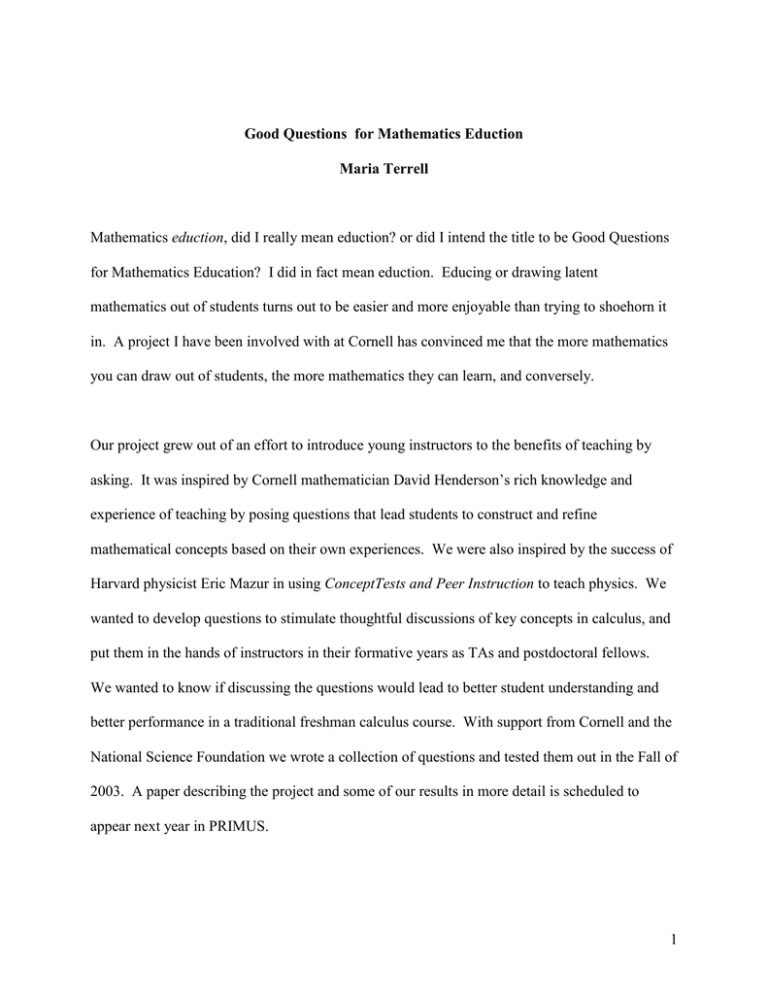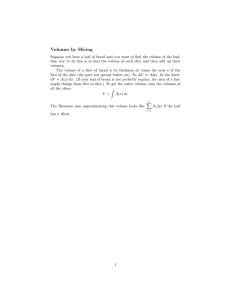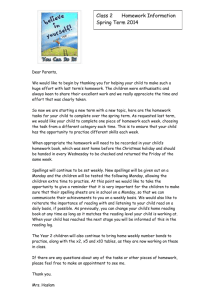eduction for Mathematics Education? I did in fact mean eduction. ... mathematics out of students turns out to be easier and...
advertisement

Good Questions for Mathematics Eduction Maria Terrell Mathematics eduction, did I really mean eduction? or did I intend the title to be Good Questions for Mathematics Education? I did in fact mean eduction. Educing or drawing latent mathematics out of students turns out to be easier and more enjoyable than trying to shoehorn it in. A project I have been involved with at Cornell has convinced me that the more mathematics you can draw out of students, the more mathematics they can learn, and conversely. Our project grew out of an effort to introduce young instructors to the benefits of teaching by asking. It was inspired by Cornell mathematician David Henderson’s rich knowledge and experience of teaching by posing questions that lead students to construct and refine mathematical concepts based on their own experiences. We were also inspired by the success of Harvard physicist Eric Mazur in using ConceptTests and Peer Instruction to teach physics. We wanted to develop questions to stimulate thoughtful discussions of key concepts in calculus, and put them in the hands of instructors in their formative years as TAs and postdoctoral fellows. We wanted to know if discussing the questions would lead to better student understanding and better performance in a traditional freshman calculus course. With support from Cornell and the National Science Foundation we wrote a collection of questions and tested them out in the Fall of 2003. A paper describing the project and some of our results in more detail is scheduled to appear next year in PRIMUS. 1 At this point you might be curious to see some examples of our questions, to see for yourself if they are “good”. You may also wonder how an instructor might use them, and how the students react to them. That is a brief outline of the rest of my talk. What do I mean by a “good question”? We have found that the best questions tap into what students already know about a mathematical idea and draw them into conversations about it. Here is an example. You’ve decided to estimate e2 by squaring longer decimal approximations of e =2.71828… a) This is a good idea because e is a rational number. b) This is a good idea because y = x2 is a continuous function. c) This is a bad idea because e is irrational. d) This is a good idea because y = ex is a continuous function. Following Mazur we have a routine about how we ask our questions. Students vote anonymously and the instructor views their responses. Students are invited to discuss their responses with each other to refine their thinking. Peer discussion is followed by a revote. The second vote is followed by a recap of what was learned. When we used an electronic polling system, we found that for this question on the first polling, generally 70% of students chose (d) an attractive but incorrect response, 15% chose (b) , 10% chose (c), and 5% chose (a). However, in the course of peer discussion, as students try to articulate why (d) is the correct response, they find themselves looking for connections between the formal definition of continuity and 2 sketches of y = ex . Through their discussions students learn that the process that they employed intuitively involves approaching e, not 2. A second polling usually shows that better than 80% of the students choose (b). In general this large shift in correct responses is not due to students with the correct response convincing others, it is students with incorrect responses clarifying their thinking with their peers and making the observation themselves. They find that squaring is a continuous operation. Connecting their intuition with the formal mathematical language gives students a precise way of discussing a phenomenon they have experienced intuitively, that is that you can get a number as close as you like to e2 by squaring a number that is close enough to e. In this way the formal definition of continuity is seen to provide a language that not only represents, but clarifies and validates their intuition. The next question invites students to interpret and reason about the derivative in a physical context that is natural, familiar, but non-numerical and non-graphical. When you slice a loaf of bread, the volume, V, changes as a function of its length, L. dV/dL is a) the surface area of the part of the loaf that’s left. b) the area of the cut face of the loaf. c) the volume of the last slice divided by the thickness of the last slice. d) impossible to determine without a specific formula or a graph. This question has many useful variations and extends to other questions and realizations of key calculus ideas, change, the rate of change, accumulation, and even the Mean Value Theorem. If our loaf looks like Wonderbread, almost everyone can see that the rate of change is constant, and 3 that the constant of proportionality is the cross-sectional area of the loaf. Every slice of Wonderbread of a certain thickness gives you the same amount of bread. But a loaf of Italian bread, with a large rise in the middle is quite different. Slices of the same thickness from the center and from the end have different volumes. A hungry student is perfectly capable of ascertaining which piece of bread they want and why, but students are unaccustomed to thinking about changing rates of change in physical terms that do not depend on time, and they rarely are asked to relate their formal notion of the derivative to their intuitive sense of which slice of bread has more volume and why. Many students guess a) and b), but they are not at all sure and they freely admit that they are guessing. A few think that c) looks close (and they are right). D) is attractive and many students think that you simply can’t talk about functions for which you don’t have graphical, tabular, or formulaic expressions. During the discussion, some students begin to see that the change in the volume of the loaf is the volume of a slice, and that the change in the length is the thickness of that slice. What is very difficult for them to notice initially is that the difference quotient, the volume of a slice divided by its thickness, is trapped between the largest and smallest cross sectional area of the slice. Once they see that, they see that as the thickness of the slice approaches 0, the difference quotient is trapped between two numbers that are approaching the same number—the area of the cut face of the loaf. Hence by talking through the definition, the derivative of the volume with respect to the length is seen to be the cross sectional area. Once students start seeing derivatives in slicing a loaf of bread, they start to see them everywhere. For example, when you cut a slice of pizza, the size of your slice changes as a function of the angle you make when you make the second cut. Like slicing Wonderbread, if 4 your pizza is perfectly circular, the derivative with respect to the angle is constant. Perhaps that is why most people like to cut their pizza that way –They know intuitively that if they want a piece that is twice as big, they should make the angle twice as large. Unlike the bread, it is not as easy to see immediately what that derivative is. However since students do know the area of a circle they can figure it out and it is well worth reasoning about. It will be useful to return to the example when students discuss integration using polar coordinates. Like bread, slicing pizza is a rich source of good questions. We ask them: If you slice your pizza by chopping it with a cleaver in parallel slices along its length (like the loaf of bread) what’s the derivative of that function? If you decide to eat your pizza by cutting off concentric rings of pizza, that is by changing its radius, what’s the derivative of that function? If the pizza is circular, the answers are fairly easy to deduce. If the pizza is amoeba shaped, the responses require much deeper thought. Helping students notice and reflect on the every day experiences through which they perceive relationships between changing quantities is not easy. But encouraging them to do so, helps them see how much mathematics they already know. It gives them a language to articulate what they have observed and it encourages them to study those relationships and use the language and ideas of calculus as they examine their everyday experiences. As students become comfortable connecting their own experiences and reasoning to calculus concepts they begin to look for and find more meaning in the formal aspects of the material we teach in a traditional course. Our collection of questions also includes fairly traditional questions that give students practice talking about and using notation and formal algorithms. Here is a short clip of students being asked about the derivative of y=sin-1x. class.mov It will give you a flavor of what the classroom looks like. I follow it with some excerpts from student interviews, that were part of our 5 evaluation of the project. interviews.mov I have brought along the transcripts of the interviews since some of the audio was compromised by some background noise. Excerpts of interviews.doc When we looked at how students performed on common exams we found that students who learned in sections of the course that used good questions with peer discussion did significantly better than students who were not discussing questions in class. Allocating time in class to discuss good questions appeared to enhance their performance on both the computational and conceptual aspects of the course. I have brought along preprints of the PRIMUS article that summarizes a bit of that data. preprint.pdf Thank you for the opportunity to share some of what we have learned about teaching by asking. 6

